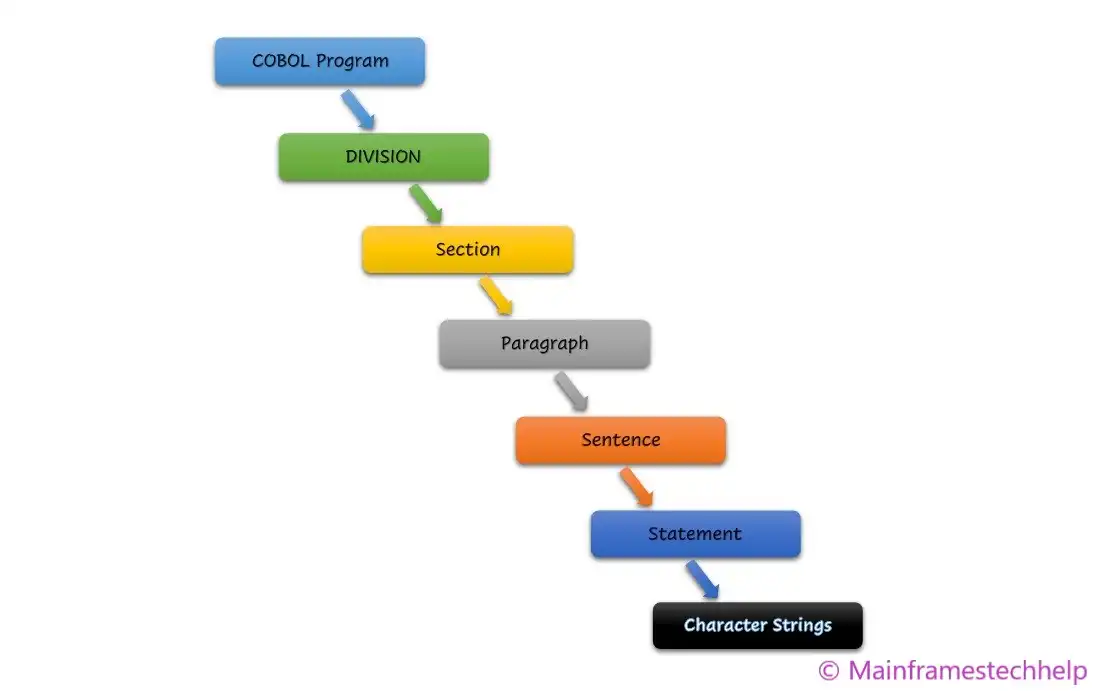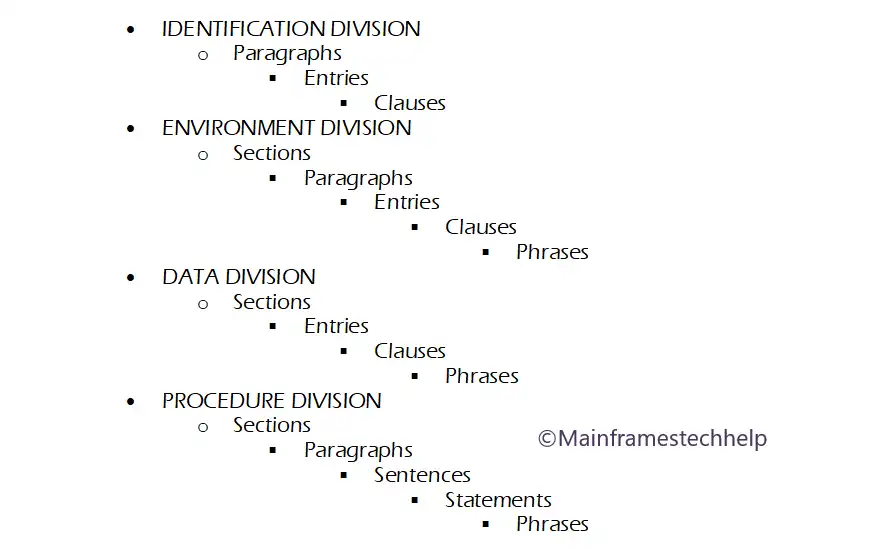COBOL Program Structure
COBOL programming language has its program structure, like other programming languages, and it should apply to every program written in the COBOL language.
COBOL program structure is a top-to-bottom hierarchical design, consisting of Divisions, Sections, Paragraphs, Sentences, Statements, and Character strings.

Let us discuss from the smaller element to the larger one for a better understanding.
Character Set -
- Character set refers to the collection of valid characters that can be used within the language.
- It is used to define literals, variables, and other identifiers in a COBOL program.
We have discussed this verb in the previous topic.
Character Strings -
- Character strings are sequences of characters that consist of letters, digits, spaces, and special characters.
- They are also known as literals, variables, keywords, etc.
- For example - WS-VAR, ZEROES, MOVE, IF, DISPLAY, etc.
Statements -
- A COBOL statement is a combination of COBOL keywords and operands. It's important to note that a statement should always include at least one COBOL keyword, as these keywords are the building blocks of the COBOL programming language.
- Statements decide the program's flow, data manipulations, input/output operations, etc.
- All statements should code in Area-B of the PROCEDURE DIVISION.
- All statements should mark with a explicit scope terminator (period - .) at the end.
- COBOL statements are divided into four types based on their usage, and those are -
- Imperative Statements
- Conditional Statements
- Delimited scope Statements
- Compiler directing Statements
For example - Two statements in a program.
----+----1----+----2----+----3----+----4----+----5
IDENTIFICATION DIVISION.
PROGRAM-ID. PROGSTRU.
AUTHOR. MTH.
PROCEDURE DIVISION.
1000-SEC1 SECTION.
1000-PARA.
DISPLAY "Hello World". --> Statement1
DISPLAY "Welcome to MTH". --> Statement2
STOP RUN.Sentences -
- A sentence is a sequence of two or more statements ended by a period (.).
- It provides a way to group related statements together, and the explicit scope terminator (period) indicates the end of the sentence.
- If the first statement ends with a period, it is considered a statement but not a sentence.
- All sentences should be coded in Area B of the PROCEDURE DIVISION.
For example - A sentence with two statements.
----+----1----+----2----+----3----+----4----+----5
IDENTIFICATION DIVISION.
PROGRAM-ID. PROGSTRU.
AUTHOR. MTH.
PROCEDURE DIVISION.
1000-SEC1 SECTION.
1000-PARA.
DISPLAY "Hello World" --|
DISPLAY "Welcome to MTH". --|--> Sentence
STOP RUN.Paragraphs -
- A paragraph is a block of code consisting of one or more sentences or statements.
- It represents a logical code unit and can be called or performed by other parts of the program.
- A paragraph coding begins with the paragraph name and ends when any of the following meets -
- Scope terminator of the same paragraph.
- Starting of another paragraph.
- Beginning of the new section.
- The program ends.
- All paragraph names should be coded in Area A, and its code should be in Area B.
For example - A paragraph in the program.
----+----1----+----2----+----3----+----4----+----5
IDENTIFICATION DIVISION.
PROGRAM-ID. PROGSTRU.
AUTHOR. MTH.
PROCEDURE DIVISION.
1000-SEC1 SECTION.
1000-PARA. --> Paragraph
DISPLAY "Hello World"
DISPLAY "Welcome to MTH".
STOP RUN.Sections -
- A section is a collection of one or more related paragraphs within the PROCEDURE DIVISION.
- Sections are coded by a name followed by the keyword SECTION. It ends at another section starting or ending the program.
- When the section is called in the program, it executes all its paragraphs sequentially.
- All section names should be coded in Area A and their code in Area B.
For example - Sections in the program.
----+----1----+----2----+----3----+----4----+----5
IDENTIFICATION DIVISION.
PROGRAM-ID. PROGSTRU.
AUTHOR. MTH.
PROCEDURE DIVISION.
1000-SEC1 SECTION. --> Section
1000-PARA.
DISPLAY "Hello World"
DISPLAY "Welcome to MTH".
STOP RUN.Divisions -
- A division is a collection of one or more sections and paragraphs.
- Division begins with the division name and ends at the beginning of the subsequent division or the program ends.
- All divisions are system-defined and should begin in Area A.
- COBOL has four divisions and those are -
- IDENTIFICATION DIVISION (program metadata).
- ENVIRONMENT DIVISION (configuration and I/O specifications).
- DATA DIVISION (data definition).
- PROCEDURE DIVISION (program logic).
For example - Sections in the program.
----+----1----+----2----+----3----+----4----+----5
IDENTIFICATION DIVISION. --> Division
PROGRAM-ID. PROGSTRU.
AUTHOR. MTH.
PROCEDURE DIVISION. --> Division
1000-SEC1 SECTION.
1000-PARA.
DISPLAY "Hello World"
DISPLAY "Welcome to MTH".
STOP RUN.Syntactical Hierarchy -
Each division has its own set of elements, and the syntactical hierarchy is shown below -

